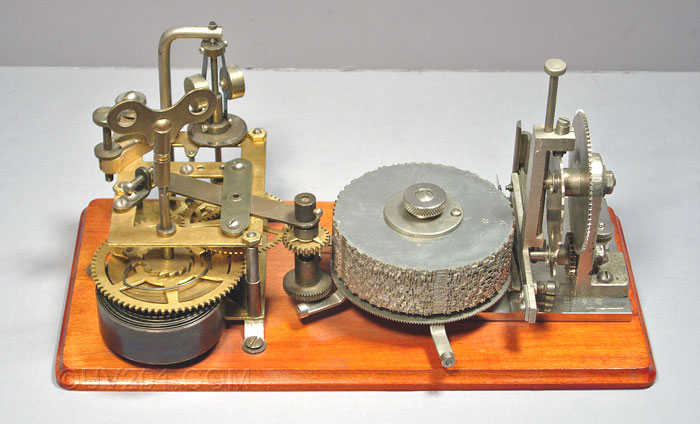| Omnigraph Morse Code Instruction Devices |
| This strange device is
known as an "Omnigraph", and it was made by the Omnigraph
Manufacturing Company of New York. It was used to teach the Morse Code to new telegraph and radio operators.
The original patents for this device were issued to Charles Chinnock on Aug 25, 1903 (736,936) and Oct. 24, 1904 (no. 773,374). The company appears to have been founded circa 1900, and to have ceased operation circa 1931. The Omnigraph model shown here consists of a variable speed spring-powered motor and a stack of aluminum disks which have patterns of dots and dashes "encoded" in their serrated edges. As the motor runs, the disks rotate, a "finger" on a leaf spring follows the pattern on the disks, and operates a set of contacts. The basic Omnigraph model used only a single code disk. This severely limited the length of the recorded code pattern, and students could cheat once they memorized what was on the disk. More expensive models solved this problem by using multiple disks and a mechanism to move the contact finger up and down to read the code patterns from each of the disks. Models using five or fifteen disks were available. The fifteen disk model is shown here, and was known as the "No. 2 Omnigraph". It cost $30 when new. There were deluxe models that had electric motors, and some very cheap ones that were hand cranked. Some had keys mounted on the board, and either a sounder or buzzer. Many different sets of disks were available, and they could be had either in Continental or American Morse code variants. |
 |
|
Extending outward from beneath the stack of disks are five metal rods which they called "message levers". As the stack rotates, each of these levers move beneath a star wheel. As each lever goes by, it rotates the wheel by a fraction of a turn. A set of gears transfers this motion to a heart-shaped cam, which moves the contact finger up and down to sample another disk. The stack of disks turns counter-clockwise, when viewed from above. To make things more interesting, any of the five levers can be individually retracted so they don't contact the star wheel as they go by. When all five are retracted, the contact finger stays on the same disk for as long as the motor runs. If one lever is extended, each disk is "played" in its entirety before moving on to the next disk. If all five are extended, only one-fifth of each disk is played before moving to the next. As the sequencing continues, all segments of each disk will eventually be played. Each of the disk segments contain 6 or 7 characters. The sequencing can also be altered by stacking the disks in different orders, and in different orientations with respect to each other. And, of course, there were alternate sets of disks that could be used. This simple, but ingenious scheme allowed the instructor to vary the patterns in nearly limitless numbers of ways, far beyond the ability of students to memorize. |
 |
| The heart-shaped cam, the star wheel, the cam follower (at the top) and the contacts. |
 |
|
This 5-disk Omnigraph is a fairly unusual version, and is the only one that I've seen that has the contact and disk mechanism located on top of the spring motor, instead of to the side. It makes for a more compact unit, if nothing else. The winding key for the motor must be removed for the unit to operate as it interferes with the movement of the message levers. |
 |
 |
|
Shown above is a 5-disk Omnigraph that was provided as part of a correspondence course that was provided by the Radio Institute of America. It dates to the early to mid- twenties. When the American Marconi Company was absorbed by RCA in 1919, the Marconi Institute (founded in 1909) became the Radio Institute of America, and later RCA Institutes, Inc. The Marconi Institute also put out the set of code instruction records shown here. Since this Omnigraph was was intended for instructing future radio operators, it was equipped with a high frequency (approx. 500 Hz.) buzzer that could be heard through headphones. The device above and just to the left of the key is a telephone-type induction coil (i.e. a transformer) which prevented the DC current needed to operate the buzzer from passing through the headphones. The key and single-ear headphone (and probably also the buzzer) were made by Bunnell. |
 |
| This page is from the instruction booklet that came with the Radio Institute of America Omnigraph. |
 |
|
This Omnigraph advertisement appeared in the April-May 1922 issue of Radio News magazine. |
 |
|
This advertisement for another correspondence school also appeared in the April-May 1922 issue of Radio News. The quality is poor, but it shows a set very similar to the one shown above. In this version, it appears to be the more expensive15-disk unit. |
| Home |
